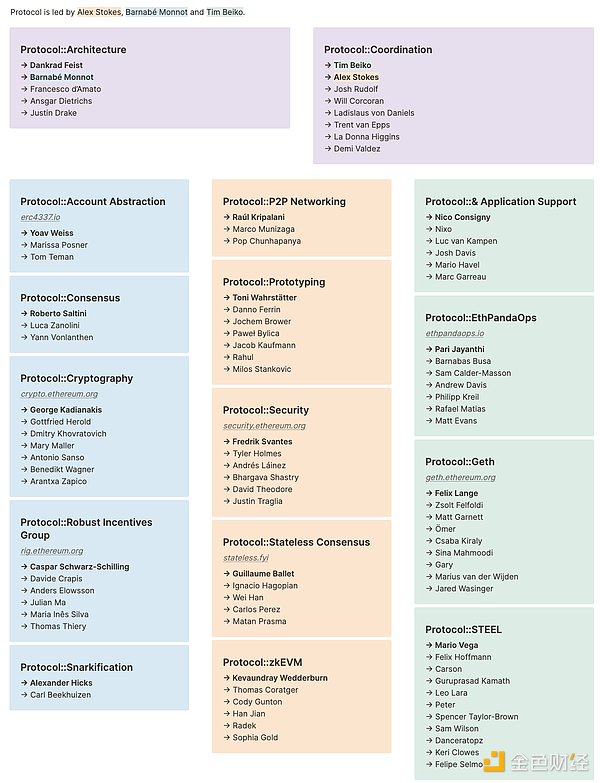Source: Ethereum Foundation, compiled by AIMan@黄金财经
Ethereum is on the verge of a major breakthrough. The rapid development of zkEVM allows us to rebuild Layer1 to support scalability, verifiability, security, and censorship resistance at the same time. L2 is constantly being strengthened to meet the needs of users and is eager to double down on Ethereum as its root of trust. In short, the world is ready for the arrival of the world computer.
These major innovations not only bring huge benefits to our users, but also enable us to attract more users. This is of great significance: this may be the best time for Ethereum to deploy our technology and our values globally.
In response, we must rethink the current approach to designing, developing, and managing the protocol. The process of "delivering the protocol" is very complex and requires us to proactively respond to needs that are difficult to express or even difficult to meet. We have a responsibility to use our skills to benefit the broader community.
Executing this mission requires our team, the protocol research and development team within the Ethereum Foundation (EF), to take focus and collaboration to a new level. This means doubling down on areas where EF has unique domain knowledge and deep expertise that is unmatched in our ecosystem: from writing mission-critical code, to publishing groundbreaking research, to coordinating large-scale projects.
To support this vision, we are changing the way we operate and refocusing on three strategic goals: scaling L1, scaling the Blob layer, and improving user experience. In practical terms, this means restructuring our teams and establishing a clear coordination structure around these strategic goals.
This also means that some members of the Protocol Development Team will no longer be working at the Ethereum Foundation. We want these people to remain in the Ethereum ecosystem, and encourage others who are building teams to seek them out.
The changes we are announcing today are different from the way we have worked in the past, but we think they will put us on a more responsive and efficient path. To mark the beginning of this new chapter and new structure, we would like to reintroduce the Protocol Development Team to the world under the new name "Protocol".
Strategic Initiatives
Over the past year, many of us have come to the conclusion that we need to better articulate our priorities. In conversations with the community, we collectively came up with three ambitious goals to achieve in the short term: scaling L1, scaling Blob, and improving user experience. Successfully achieving these goals is the most valuable work we can do for the community, and we have a responsibility to achieve it.
Now we must ensure that these goals directly drive our attention and resource allocation. Each goal is now mapped to a strategic initiative at Protocol, a shared workspace that brings together our complementary talents. We encourage every team at Protocol to think about how their work supports our execution of these strategic initiatives.
It is critical to our execution that we have leaders on our teams who are trusted by the community. We are more clearly assigning leaders to accelerate the implementation of strategic initiatives, thereby increasing accountability.
Specifically, the following individuals are responsible for ensuring EF executes on each of its strategic goals:
Scaling L1: Tim Beiko & Ansgar Dietrichs, Ethereum will provide enough block space on L1 to accommodate all asset issuance, governance, DeFi, and L2 settlement activities without compromising reliability.
Scaling L2: Alex Stokes & Francesco D'Amato, Ethereum will provide the best data access layer. Scaling the throughput of data access on Layer-1 and ensuring it becomes the most attractive product across the ecosystem.
Improving User Experience: Barnabé Monnot and Josh Rudolf, providing individuals and institutions with a unified, seamless, and secure experience in the Ethereum ecosystem.
They will be supported by Dankrad Feist, who will serve as a strategic advisor in all areas and the lead on projects developed to advance these goals.
The Team
More than ever, we need to mobilize the capabilities of all Protocol members simultaneously to solve problems. Rapidly transforming research results into prototypes and then into production means that we need tighter collaboration and feedback loops. In the past few years, we have seen more communication bridges between teams, with tangible results. With a shared vision, we must ensure that our shared home is a great working environment.
Maintaining an open collaboration with every member of Protocol requires that we have shared expectations from each other and a high level of trust that each of us can deliver results at an optimal level. Team leaders will be responsible for ensuring that their members meet our standards of technical excellence and continue to grow and surpass themselves.
Protocol is now a more united, streamlined organization with more focused teams. The updated organizational chart is as follows:

Community
The protocol cannot accomplish everything on its own. Our ecosystem benefits from the efforts of many other core R&D teams who strengthen our efforts and turn features into reality. Our role is not to replace these teams, but to set high standards for ourselves in the process of working with them.
The protocol is pushing us to reconfigure the main governance forum and introduce new governance forums. It is critical to continue to send the right signals and turn them into actions.
We are looking for new members to join us and work together as part of the broader Ethereum core development community. We believe that the positions of User Experience Director and Performance Engineering Director are critical to helping us solve real problems for Ethereum users. We also welcome outstanding applicants who are passionate about our mission, please let us know via our Common Application.
So, let's get moving and deliver the deal.
 Brian
Brian
 Brian
Brian Kikyo
Kikyo Brian
Brian Brian
Brian Kikyo
Kikyo Alex
Alex Joy
Joy Brian
Brian Joy
Joy Joy
Joy